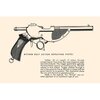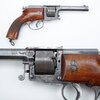Rex in OTZ
Member
- Joined
- Nov 29, 2019
- Messages
- 616
That has to be the inspiration for the 'Noisy Cricket' from the Men In Black movies.The funky Italian squeeze pistol.
View attachment 939468
Tribuzio
cal. 7.65 mm, 6-shot self-contained magazine.
It was invented in 1890 by "Catello Tribuzio" of Turin, Italy.
The barrel and side plates are metal with blue finish and the frame and trigger are brass with nickel finish.
View attachment 939469 View attachment 939470 View attachment 939471
Connecticut Arms Hammond Bulldog Single Shot Pistol
They were available in .22, .32, .38, .44 and .50 calibers which features a rotating breech block.
View attachment 940560 View attachment 940561 View attachment 940562
Hino-Komuro 1908
.32ACP Hino-KomuroView attachment 940971 View attachment 940972 unique blow-forward mechanism, which makes it very interesting to study. The rear of the receiver houses a fixed firing pin, and the barrel is pushed forward upon firing.
Now we have reached a loggerhead.No way is this steampunk, this is Star Wars
But some movin Picture show movies on it.







